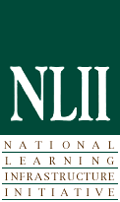

Deeper Learning
Design
Implications
Technology
Uses
Learning
Activities
Mapping
the Learning Space:
Teaching Practices for Higher Education
A multitude of factors have come together in rapid progression to change the way higher education approaches the classroom, teaching and learning. No better background on these changes can be found than in the Association of American Colleges and Universities' (AAC&U) panel report Great Expectations: A New Vision for Learning as a Nation Goes to College.
Technology is rapidly changing
what we call a course. The rapid adoption of course management systems
by faculty across the curriculum has expanded the classroom experience
to anytime, anywhere; web-enhanced, hybrid and completely online
students are now able to engage in learning and questioning that fits
their schedule, learning style and ability.
The student population is rapidly changing and most campuses see a more diverse student body. Race, age, economics, parenting, full-time jobs, and preparedness of students have all recently influenced faculty approach to planning curriculum.
Faculty bodies are changing everywhere. The economics and privatization of higher education has caused rapid changes in the faculty profile, with some studies suggesting that less than 35% of the national faculty body are full-time, tenure-track positions. Consequently, more higher education faculty spend 100% of their faculty time concentrating on the responsibilities of teaching without significant support or guidance from the institution. The combinatorics of these rapid changes have created a growing interest in understanding and re-evaluating the concept of course design.
Instructional design choices, in use of materials as well as elements of the syllabus, should be selected based on the desired outcomes of the course. A number of technologies are now available across the curriculum that can assist the instructor in making course material come alive, be more clearly understood, or become more accessible for diverse, visual and active learners.
A great service to the academic community is provided by the Multimedia Educational Resource for Learning and Online Teaching (MERLOT) site in providing peer-reviewed links to learning materials, as well as pedagogical assistance to faculty in determining how and when to use online materials.
Faculty dedicated to teaching are now exploring best practices for active, engaged, learner-centered teaching.
"I hear and I forget, I see and I
remember, I do and I understand."
-Confucius
I
How do we bring 'doing' to the classroom? How do we step off the stage and create an environment where students are empowered to collaborate, interact, work in teams, incorporate their own talents and ways of thinking, work on real world and locally identifiable problems, work in ways that have meaning to their needs, experiences and outcomes?
A start for many faculty is
to rely on others, whether for training in course management systems and
best practices for student-driven discussions, for assistance in course
design from teaching and learning centers on campus, in collaboration with
instructional designers, academic technology support staff and librarians.
Collaboration in the incorporation of resources, tools and active learning
practices is changing higher education and has the possibility of transforming
teaching and learning.
The social technologies of Web 2.0, for the most part free resources available to anyone with internet access, allow learners to share in creating collaborative knowledge through blogs, wikis, ePortfolios, shared documents, shared images, shared resources and team-built understandings. Collaboration, consenus, social knowledge and networked knowledge may be the natural fusion of technology, teaching and learning.